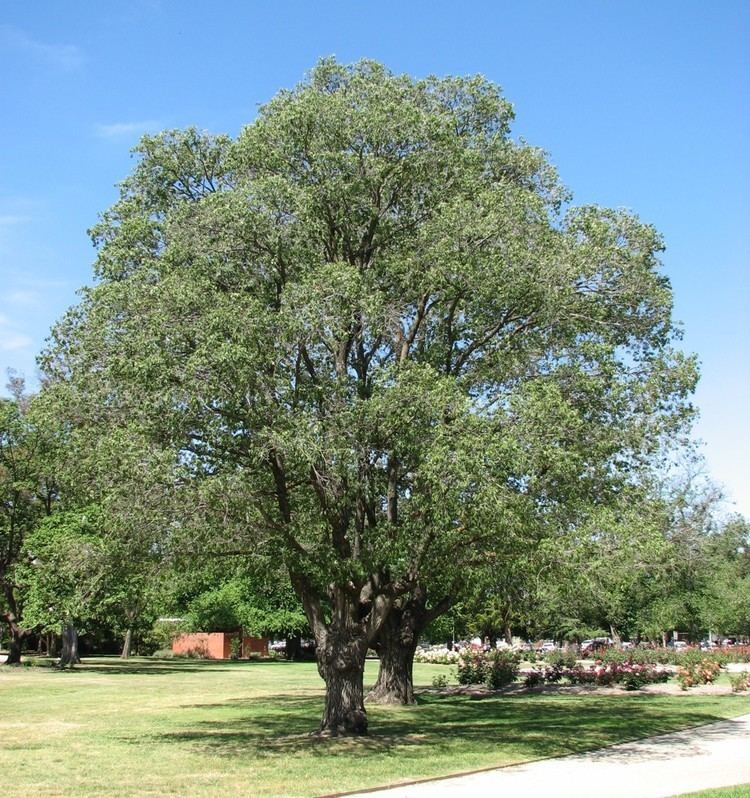Origin England | ||
 | ||
Hybrid parentage U. minor × U. minor 'Plotii' People also search for Ulmus americana 'Incisa' | ||
Ulmus × viminalis (:'willow-like elm'), occasionally referred to as the Twiggy Field Elm, is a natural hybrid between U. minor and U. minor 'Plotii' which occurs in England where the two trees overlap. According to Henry, this was the tree first described in 1677 by Robert Plot from specimens growing in an avenue and coppice at Hanwell near Banbury, though the name 'Plot's Elm' was later given by George Claridge Druce not to this hybrid but to one of its parents. However, writing in 1940 and referring to a pencil rubbing in Herb. Druce, vol. 113 of the Sloane Collection, Melville questioned Henry's claim. "I can see no reason to doubt that this is Plot's plant," but "it is [not] U. × viminalis ".
Contents
- Description
- Pests and diseases
- Cultivation
- Notable trees
- Cultivars
- Synonymy
- North America
- Europe
- Australasia
- References
U. × viminalis was once commonly treated as a variety of English Elm and listed as U. campestris var. viminalis, before it was determined as a hybrid by Melville. A number of ornamental forms have been in cultivation since the 19th century (see Cultivars below).
Description
Trees of the U. × viminalis group vary in characteristics according to their U. minor parentage. Henry's "tree with ascending branches, pendulous branchlets, and sparse foliage" and Bean's "narrow-headed, rather slender tree" accord with what would be expected from a crossing of Plot Elm and Field Elm. Trees of the U. × viminalis group are slow-growing; they can ultimately reach 20 m in height. Leaves vary from obovate-elliptic to narrowly elliptic; they are deeply serrated, < 5.0 cm long, nearly symmetrical at the base and long-acuminate at the tip, with prominent white axil tufts on the undersides. See also Description under Cultivars (below).
Pests and diseases
Trees of the U. × viminalis group are very susceptible to Dutch elm disease. A specimen at the Ryston Hall [1], Norfolk, arboretum, obtained from the Späth nursery in Berlin before 1914, was killed by the earlier strain of Dutch elm disease prevalent in the 1930s.
Cultivation
Cultivars of the U. × viminalis group (see below) have been introduced to continental Europe, North America and Australasia, where a few specimens survive in arboreta. Three trees, at different times labelled U. × viminalis and U. 'Viminalis' (but, from their shape, possibly 'Betulaefolia'), and pollarded in 1984, stand in Benalla Botanic Gardens, Australia. One tree, determined as U. viminalis Lodd by Melville, 40 feet (12 m) in height stood by lake at the Royal Botanic Gardens, Melbourne in 1953. Not all U. × viminalis cultivars match named cultivar types. Three specimens supplied by the Späth nursery to the Royal Botanic Garden Edinburgh in 1902 as Ulmus campestris viminalis (see External links below) were determined by Melville in 1958 as U. viminalis Lodd but "not the usual nothomorph". One stood in the Garden itself; two may still exist in Edinburgh as it was the practice of the Garden to distribute trees about the city.
Notable trees
A number of old non-ornamental U. × viminalis survive (2015) in a wood in Mepal, Cambridgeshire.
Cultivars
Aurea, Betulaefolia, Gracilis, Incisa, Marginata, Pendula, Pulverulenta, Stricta, Viminalis.
